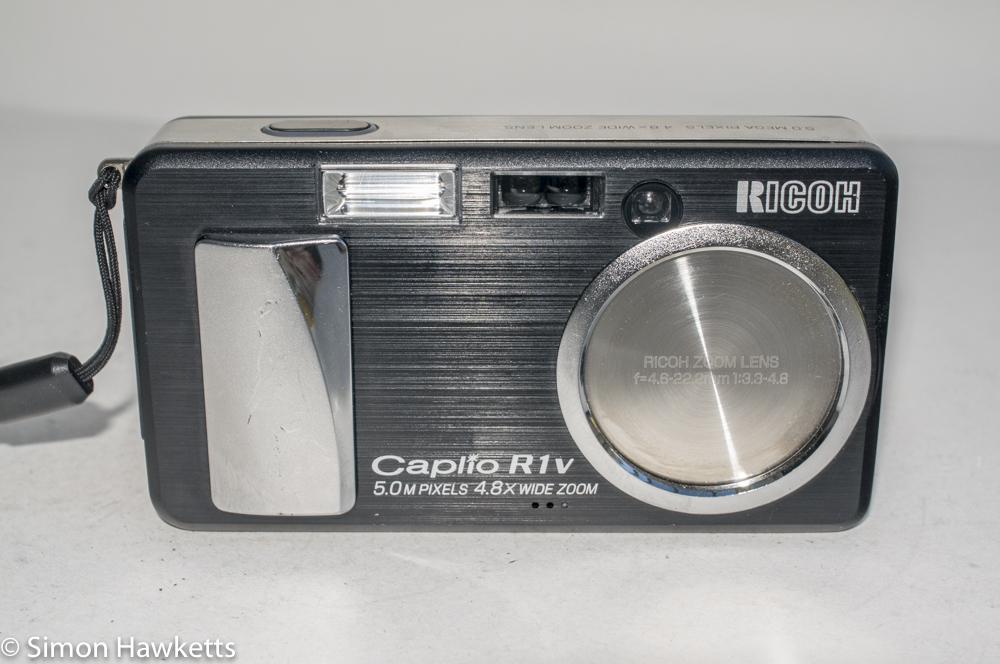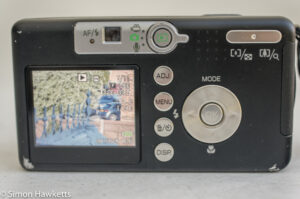Ricoh Caplio R1v digital compact camera
I’ve had a soft spot for the Ricoh Caplio range of digital cameras for a while now, so I was really pleased to pick up a Ricoh Caplio R1v as part of a bundle purchase of cameras recently. It is a small, fully automatic, 5Mp snapshot camera dating from about 2005 with several interesting features which are typical of the Ricoh range.
Ricoh Caplio R1v Images








My Ricoh Caplio R1v Camera
As I said above, I managed to pick up this camera as part of a bundle someone sold which was listed as simply ‘old digital cameras’.
I actually bid on the bundle because I could see from the rather fuzzy pictures that one of the units was a Nikon Coolpix 995 swivel camera. I’ve had the 995 on my ‘wish list’ since I picked up a Coolpix 950 a few months ago, and I was amazed when I got the bundle of 5 cameras for only £5.
When the bundle turned up I found it consisted of the Nikon Coolpix 995, an Olympus Camedia C2040 Zoom, a Canon Digital IXUS V3, a Praktica Nova 1B and this Ricoh Caplio R1v – quite a haul for £5! I’ve tried the Nikon, Olympus, Praktica and the Ricoh, and they all seem fine. The battery on the Canon seems to be completely shot, so I don’t know if that works or not yet.
The Ricoh is in pretty good condition – a couple of marks here and there and a little scratch on the back LCD, but generally OK. When I first put some batteries in it, I thought that there was a problem because although I could get the display function to work, I couldn’t get the camera itself to work. I played around with it for a while, and then in frustration I found the manual online and discovered I had to push the grip on the front panel to turn the camera on.
Once I’d worked that out, everything sprang to life!
Ricoh Caplio R1v Description
As I said above, the R1v is a compact, snapshot camera of the sort which has almost totally disappeared now that mobile phones have such good cameras fitted to them.
It is a reasonably tough camera, made from an aluminium body shell with a steel decorative band wrapped round the top and sides, and small enough to easily fit in a pocket or bag. In use, it is quite responsive, being ready to take a picture in only a couple of seconds from turn on. That actually makes it at least as responsive as most modern smartphones to take a picture.
The controls are mostly fitted to the back of the camera with a line of buttons down the side of the LCD, a 4 way switch with a central OK button, a zoom rocker switch and a selector switch fitted next to the viewfinder.
The shutter release button is on the top of the camera shell, and the on / off switch is on the front. On the side of the unit is a press & slide rubber door which holds the SD card and either 2 AA batteries or a rechargeable battery.
As said above, the camera is turned on by sliding the front grip out towards the edge of the camera. This action opens the lens protection cover, extends the lens and switches on the back panel LCD.
The LCD is used for composing the picture, but one of the advantages of older cameras like this is the addition of an optical viewfinder as well as the LCD, making it much easier to frame subjects in bright sunlight. That is particularly important for this style of camera, which was mostly made for taking on holiday or trips. The optical viewfinder is coupled to the zoom action of the lens, and the autofocus LED is within eyesight when using it, so it’s quite easy to use and get accurate results with it.
One of the things I particularly like about Ricoh cameras is that they are made for photographers. What do I mean by that? Well, even though this is a snapshot camera, there are a number of features which many keen photographers would like; for example when the shutter button is half pressed so the autofocus kicks in, the display shows the f-stop and shutter speed which will be used to take the picture. Although that can’t be changed by the photographer, it is still useful information to see. There are also various options such as setting the metering mode, ISO, a histogram on the display etc which you would expect in a ‘proper’ camera.
So, a few details about the Caplio R1v. The exposure is completely automatic and can’t be overridden, although there is the option to add exposure compensation in situations where you think the metering may have been fooled by backlighting, or you want detail in a shadow area.
There is also the option to bracket the exposure by +/- 0.5EV, which is an option not usually found on snapshot cameras – another nod to keen photographers. Although the exposure can’t be overridden, it is possible to set an option which will stop the camera selecting shutter speeds below a set level – 1/8sec @ wide angle and 1/30sec @ telephoto focal lengths which is useful when the camera will be hand held.
It is possible to set the focus to manual, but realistically this is not really an option in a camera of this type; the focus is controlled by the zoom buttons and is difficult to accurately judge, although a screen enlarge function is supplied. The more interesting focus option is ‘snap’, which automatically fixes the focus at either 2.5M or infinity, making it ideal for holiday snapshots and allows the camera to quickly respond without having to autofocus. This is one of those Ricoh functions which distinguishes their cameras – I don’t think I’ve seen this option on any other make, but all the Ricoh Digital cameras I own have it.
Another useful focus function is the built-in macro mode, which allows the camera to focus down to 1 cm from the front of the lens when set to wide angle. This is particularly useful in small sensor cameras because of the much larger depth of field they provide, making them in some ways superior to modern mirrorless or DSLR cameras for this particular purpose.
For specific scenes there are pre-set camera modes available – Portrait, Sports, Landscape, Night-scape, Text mode and High sensitivity which are selectable with a press of the up arrow on the 4 way controller. Another similar function is Multi Shot – In this mode, the shutter release is held down, and the camera takes 16 images in quick succession and assembles them into a single picture of separate images. That is quite a useful function if you want to record a sequence or action – again, I don’t think this sort of function was widely available at the time.
So that is a brief run through of some of the features of this quite remarkable little camera. It is by no means an exhaustive list – that is provided in the manual, which I’ve linked to below.
In the next part of this review, I will include some sample photos I’ve taken with the camera, and my impressions of shooting with it.
Ricoh Caplio R1v Specification
- Ricoh Caplio R1v 5Mp digital compact camera
- Manufactured in about 2005
- 1.8inch 110k LCD screen
- Optical viewfinder
- Autofocus with confirmation LED at viewfinder level
- Manual focus with enlarged focus area
- Snap focus at 2.5M and Infinity
- Self timer, Long time exposure, Interval shooting.
- 4.8x optical zoom
- 28 to 135mm eq zoom
- 8sec to 1/2000sec shutter speeds (automatically selected)
- Exposure and white balance bracketing
- f/3.3 to f/4.8 max aperture
- Macro mode focuses to 1cm from lens
- Picture ‘scene’ modes
- Multishot (like continuous shooting but all pictures in one image)
- Selectable metering modes – spot, centre weighted, matrix
- +/- 2 stops of exposure compensation
- Auto + 5 preset white balance including manual
- ISO 64 to 800 + auto
- 5 different LCD display options
- Continuous or step zoom
- Sound recorder
- Video recording at 320 x 240
- Jpeg, Tiff, Wav and Avi file formats
- Power 2xAA battery or rechargeable
- SD card memory + 12M internal memory
- Video & USB sockets
- Ser No: 74104526
- Handbook available online here
Discover more from Everything Vintage
Subscribe to get the latest posts sent to your email.






